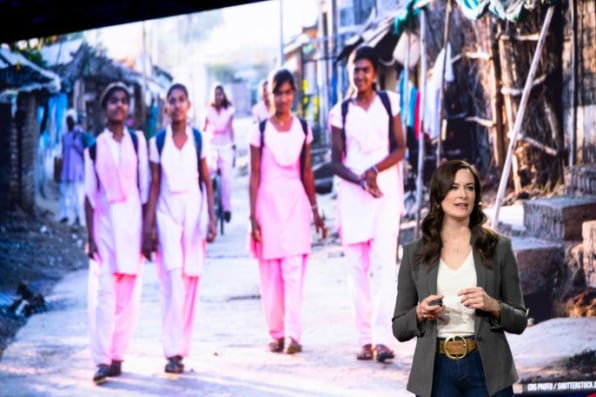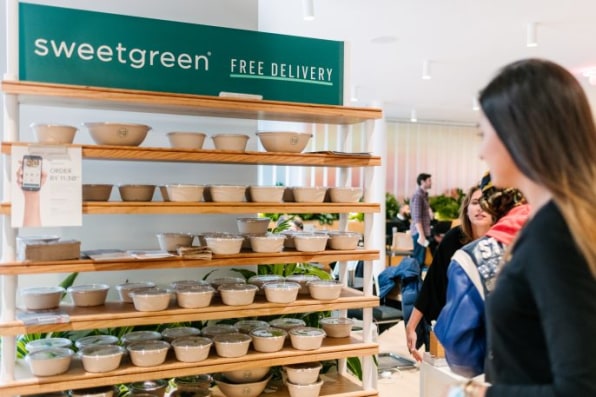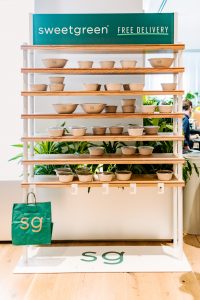In 2015, Tim Reed was a 24-year-old unemployed, college dropout. Money troubles had forced him to put his electrical engineering degree on hold at Morgan State University before a failing grade at the Community College of Baltimore County put another halt in his education plans.
Reed had no choice but to move back into his parent’s home. Needless to say, he needed to make some moves.
It was around this time that he came across a vague Craigslist advertisement that read: “Get paid to become a software developer” with mention that 20-weeks of training would be provided at no cost to the jobseeker and a guaranteed job would be waiting upon completion.
Reed thought the ad was a scam and moved on with his job search. That was until he saw the same ad on job search site Indeed. He still wasn’t convinced.
“It took me a week to fully, in my spirit, to say ‘just go for it,'” he says.
One day, when the house was empty and his siblings were at school, Reed completed the required assessment, which took nearly three hours. He says thought he wouldn’t get an offer because he was stumped by a few calculus questions.
What Reed didn’t know at the time was that the calculus questions were meant to induce anxiety to screen test-takers for their cognitive agility and problem-solving abilities under pressure. In short, while Reed was taking the assessment, the technology was watching how he was taking the test.
When the test isn’t about the questions
Exactly what is being measured here? Keystrokes to measure against the thousands of variables that the AI and predictive analytics system will later use to spit out a probability score to determine potential. For instance, to test for grit, the technology watches how an individual reacts in stressful situations. Do they open multiple browsers when they’re stuck on a problem, which signals that they know where to go even if they don’t initially know the answer? Or when the test-taker is provided more information in a later question, do they then go back to an earlier question to change their previous answer? The company says if they do, this shows cognitive agility.
The reasoning for the assessment is to identify potentially high-performing engineers who are often overlooked for opportunities because of cultural markers and outdated hiring practices.
An “onshoring” model to improve chances of upward mobility
Catalyte is the company behind the proprietary artificial intelligence and predictive analytics.
The idea was planted in Michael Rosenbaum’s head almost two decades ago while he was an advisor in the Clinton White House. At the time, the Clinton administration was encouraging the private sector to grow in low-income communities to solve for untapped market potential. Rosenbaum, a Harvard economics and law fellow, argued that the bigger opportunity is that underserved urban populations held untapped labor markets.
In the late 1990s, manufacturing jobs were going overseas, yet the internet boom meant there was an influx of opportunities for people who could do simple HTML coding.
Rosenbaum had an idea: What if we could move people from the side of the economy that’s contracting to the side that’s growing? That is, the tech industry, particularly high-demand software engineering jobs. By 2020, the U.S. Department of Labor projects there will be 1.4 million job openings for computer and technology specialists, yet only enough graduates to fill 29% of those openings. These realities, along with the recent push to outsource domestically so that software teams are closely tied with the business and customers, resulted in an “onshoring” model that is quickly shifting the long-standing IT services outsourcing one.
Rosenbaum believes that enabling people can change the trajectory of entire families through the transformative opportunity for upward socioeconomic mobility. If there was a way to test for potential, then someone who grew up in generations of poverty can break the chains and make six-figure salaries within a handful of years (the national average salary for a software engineer is $115,462, according to Glassdoor). If the model is successful, the wage gap narrows and desolated, post-manufacturing cities forgotten about after their industries collapsed, can start rebuilding themselves.
Fast-forward 18 years since Catalyte’s inception in 2000 and the company now has development centers in Baltimore, Portland, and Chicago. Catalyte claims it’s a hyperlocal model, meaning the workforce in the development centers reflects the demographics in the area. For example, the Baltimore metro area is 28% African-American and the development center in that city employs 26% African-American engineers. According to the company, its model is scalable and it plans to have 20 centers up and running by 2020, including the Denver and Dallas centers projected to be open for business by the end of the year.
“One of our biggest missions is improving social mobility, so we look at places that have big socioeconomic inequalities,” says CEO Jacob Hsu. Other factors include metro areas where there’s a large pool of local talent and “a big anchor client” that commits to a number of people they want to bring on locally.
Ending resume pedigree with predictive analytics
About a month after Reed completed Catalyte’s assessment, he was asked to come in for an interview at the development center located in Baltimore’s Federal Reserve Building. Next, Reed was invited to complete 20 weeks of in-person training, which would cover the ins and outs of coding required of a full-stack enterprise software developer, while also being groomed with the soft skills needed to be a successful consultant for Catalyte’s Fortune 500 clients, including Under Armour, Aetna, Microsoft, and AT&T.
As the ad promised, there is no cost for the training bootcamp but full-time attendance, from Monday through Friday, 9 a.m. to 4 p.m., is required. A stipend is offered in the last six weeks of the program. Needless to say, additional financial support is needed for aspiring developers to complete Catalyte’s program, and may be one of the reasons why 25% of the people who start do not finish. The vast majority drop out early on.
Reed worked odd jobs in recycling and truck driving to make ends meet and graduated alongside 12 of the 20 he started the program with. Upon completion of the program, graduates receive a salaried full-time offer with benefits, health insurance, and an annual stipend with Catalyte. The condition is that they stay with the company for two years and, to cover training costs, salaries during this time are around $40,000–less than half the salary of an entry-level software engineer. If the individual breaks the two-year contract, there is a monetary penalty, which according to this Glassdoor review from February 2018 and this one from September 2014, is $25,000.
If hires decide to stay with Catalyte after the completion of their two-year contract, a market adjustment is made in the third year, which takes into account factors like individual skill-sets and performance in client work. At this point, “[most people] go from right around $40,000 to the average $75,000 salary,” says Paige Cox Lisk, Catalyte’s chief people officer.
According to Rosenbaum, not everyone can be a great software developer, but great software developers can come from anywhere. Graduates from the program come from a spectrum of industries: construction workers, baristas, even PhD and MBA degree holders who are looking for a career change. The youngest test-taker who passed was a 17-year-old high school senior and the oldest person was a 72-year-old retired civil engineer. At Catalyte, developers look like Reed, who is the first engineer in a family working mostly in skilled trades jobs. Or Nastassia Pishchykava, who immigrated from Belarus and couldn’t get an entry-level engineering job, despite having the degree for it, because she needed experience first. Or Rob Winkler, who previously worked at the United Postal Service before leaving to make a career change. In Winkler’s third year working at Catalyte, his salary increased by 60% from when he started. Today, the company employs about 300 full-time people, with 60% coming from its training program.
In the last three years, a lot has changed at Catalyte. The company survived its first major layoffs, which hit Reed in the middle of his first year working for the company in 2016. “I was hurt, disdained, angry,” Reed says of the experience. “There was no real explanation behind [the layoff] except for performance…both the company’s and mine. About six months later, Catalyte rehired most of the people it laid off, including Reed. Inside company walls, the layoff is referred to as “the Red Monday.”
In January 2017, Silicon Valley executive Hsu joined the company as CEO. Shortly after, Catalyte was among the first investments for the Rise of the Rest Seed Fund raised by AOL cofounder Steve Case’s D.C. venture firm Revolution. The $150 million seed fund was created to invest in local companies outside major tech havens, with the idea being that without access to funding, these communities are forgotten and sometimes left to die a slow and painful death (75% of VC dollars in 2016 were invested in companies in only three states: California, Massachusetts, and New York).
Earlier this year, Catalyte used some of the $27 million in funding it received to acquire Surge, a Seattle-based software development company that provides senior-level engineers, who will now work on a 1099 basis for Catalyte and handle specialized projects.
Recently, the company hired Tom Iler as its chief product officer, a 20-plus year veteran in IT who was attracted to Catalyte’s model because he’s long hired people for aptitude and attitude, instead of skills and experience. In fact, he tells Fast Company this approach is his “secret to success” because “you can train them to do just about anything” if they have the right aptitude and attitude. Under Iler’s guidance, Catalyte’s assessment, aside from testing for an individual’s innate ability to grasp technical concepts and cognitive agility, will also measure an individual’s emotional quotient, or EQ.
“Think about how powerful it would be if we could identify the personality traits in our most successful developers,” says Cox Lisk, “and weave it back into the assessment.”
The company is currently working on an alumni study to track how the program has fared for all Catalytes–the 1,700 people who have graduated from the program–whether they stay or leave the company after completing their training and apprenticeship.
In three to five years, if Catalyte is known as “the largest software development service company in the world,” Hsu says it would’ve failed: “We would’ve missed the boat because our ultimate ambition is to change the way we connect opportunity to potential. We want to kill pedigree. We’re proving it now with software developers. Our goal is to do this across industries so that we can make a much more diverse, egalitarian workforce, where everybody gets a shot if they can prove that they have the potential.”
Aside from convincing financial decision-makers that success can come from anywhere and look like anybody, Catalyte’s model, if successfully scalable, can also prove this to those at the base of the economic pyramid. Reed, now an application developer (who has since received his Associate’s degree, paid for by Catalyte), says he has friends who have witnessed his success, but are too afraid to take the plunge themselves.
When asked why, he says: “I think it’s the image of a software engineer. The positive is Bill Gates, Microsoft, and Google. The negative image is of a hacker. But both of those pictures are a form of higher intelligence…some super-smart people do that. [My friends] can’t imagine themselves being those people.”
Correction: A previous version of this article misstated the number of participants who complete the Catalyte program.
![]()

















